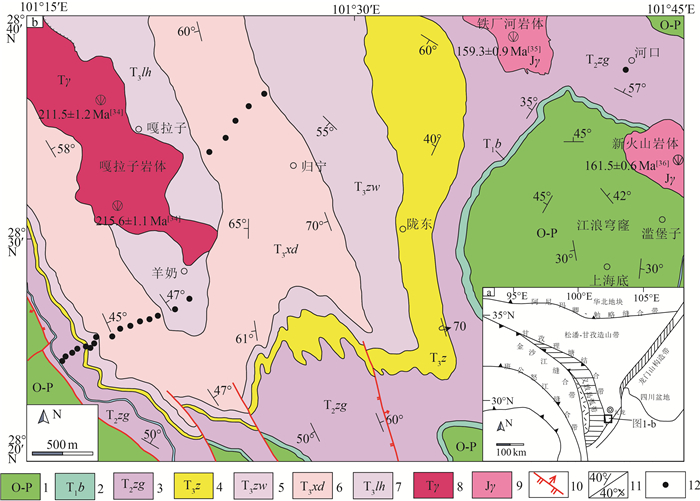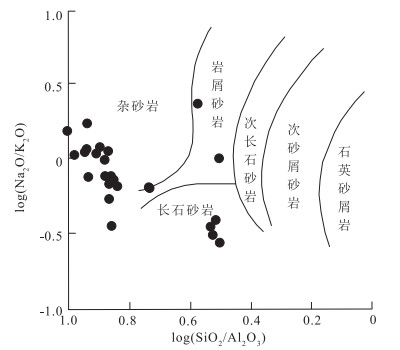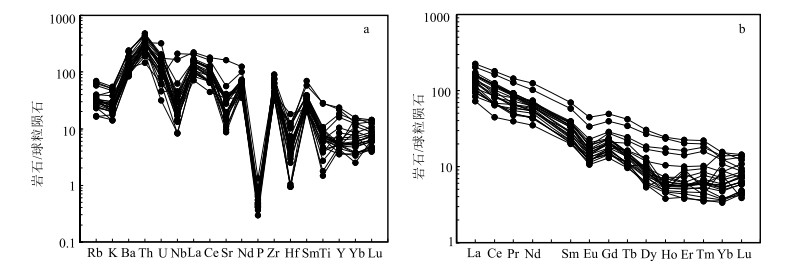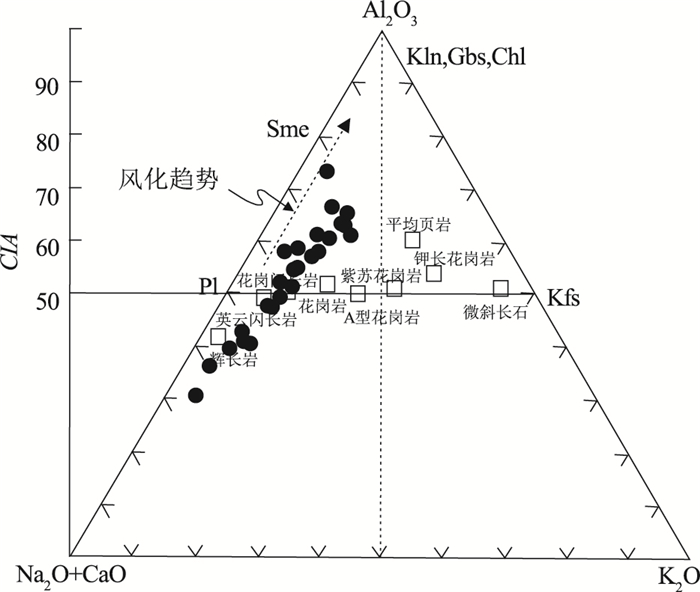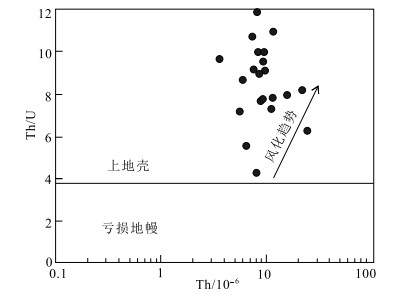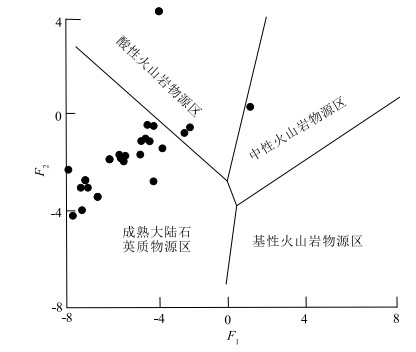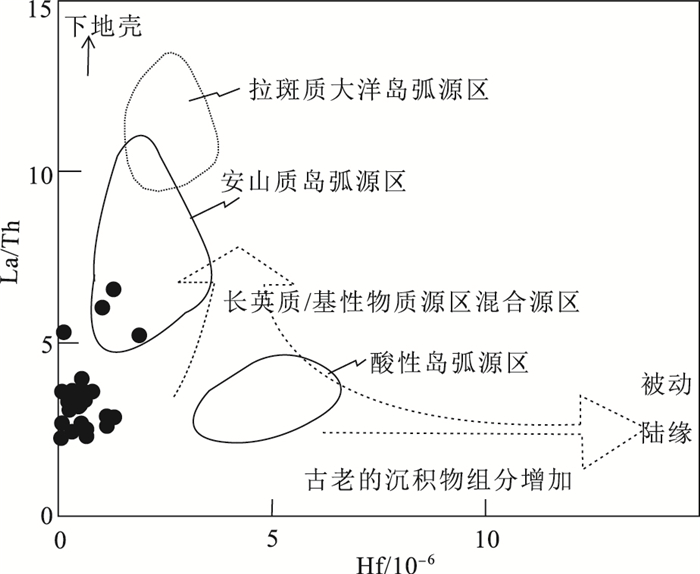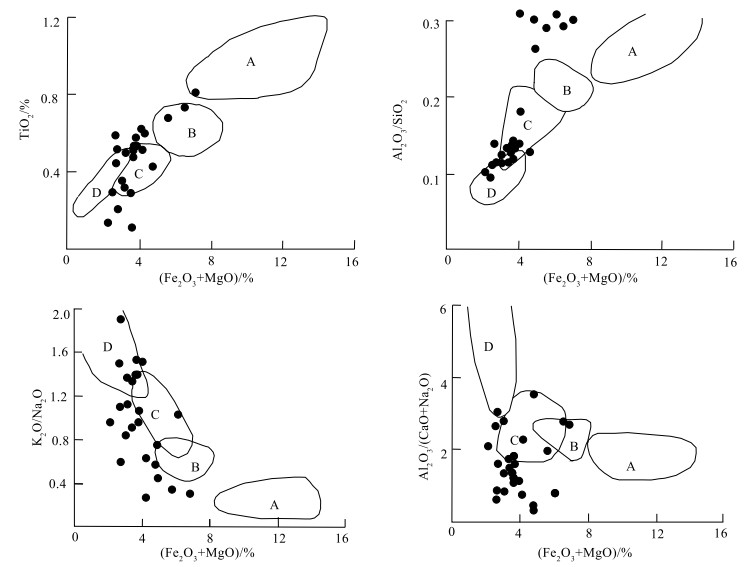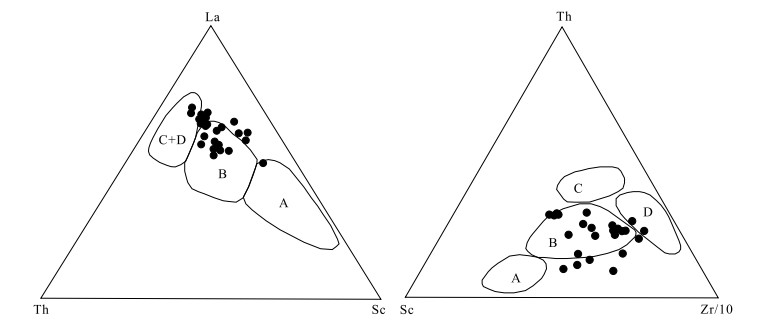Tectonic setting and provenance of the Xikang Group in the Guining area, West Sichuan Province: Constraints from geochemistry of clastic sedimentary rocks
-
摘要:
川西归宁地区紧邻江浪穹隆和长枪穹隆,大面积出露三叠系西康群,主体表现为一套浅变质的浊积岩复理石建造。对该套地层的碎屑岩进行岩石学、地球化学特征研究,并对物源和其亲缘关系进行了探讨。结果显示,砂岩主量元素SiO2、P2O5与上地壳相近,CaO、MgO较高,而Al2O3、Fe2O3、K2O、TiO2含量偏低;微量元素蛛网图呈"M"型向右缓倾,富Th、U、La、Nd、Zr、Sm,贫K、Nb、Sr、P、Hf元素;样品轻、重稀土元素分馏明显,属轻稀土元素富集型,具中等负Eu异常;化学蚀变指数及成分成熟度均偏低,反映出物源区化学风化程度弱,沉积物具近源快速堆积的特征,是活动构造带的首次沉积;砂岩-泥岩套的物源区指纹判别图解及微量元素值显示该区西康群为上地壳长英质物源区。根据地球化学构造判别图解,并结合野外调查的古水流和古地理重建的证据,该套碎屑岩沉积于活动大陆边缘及大陆岛弧的构造背景,其物源区有可能来自于南东方向邻近的康滇古陆,与扬子地块西缘具有较强的亲缘关系。
Abstract:The Xikang Group, distributed in the Guining area between the Changqiang Dome and Jianglang Dome in West Sichuan Province, is one set of low metamorphosed turbidite flysch.Based on the study of their petrological and geochemical characteristics of the clastic rocks, the provenance and affiliation were analyzed. The results show that the major elements of the sandstone, SiO2 and P2O5, are similar to the upper crust, with relatively high CaO and MgO, while the contents of Al2O3, Fe2O3, K2O and TiO2 are relatively low.The Chondrite-normalized trace element spider diagram of clastic sedimentary rocks is "M"-shaped and inclined to the right, rich in Th, U, La, Nd, Zr, Sm and poor in K, Nb, Sr, P, Hf.The rare earth elements of the samples display obvious fractionation in light and heavy REE, strong enrichment in light REEs with medium negative Eu anomaly.The chemical alteration index (CIA) and composition variation index value (ICV) are both low, reflecting the weak weathering degree of the source area and the characteristics of rapid accumulation of sediments near source, which represents the first deposition of the active structural belt.The fingerprint discrimination diagram and trace element value show that the source of the Xikang Group in this area was felsic in upper crust.According to geochemical tectonic setting discrimination diagrams, the structural background of the clastic rocks is active continental margin and continental island arc.Based on the paleocurrent evidence of field investigation and the reconstruction of paleogeography, it is inferred that the provenance of the Xikang Group might have come from the Kangdian ancient land in the southeast direction, and have an affinity to the Yangtze Block.
-
Keywords:
- Xikang Group /
- geochemical characteristics /
- tectonic setting /
- provenance /
- Guining
-
“燕山运动”由著名地质学家翁文灏先生提出[1],一般泛指影响中国东部地区强烈的中生代构造运动。主要分A期地壳变动幕、中间火山幕和B期地壳变动幕[2]。21世纪前,大量学者对燕山运动的幕式运动方式提出不同看法,其中,Hsieh[3]认为可以分为5期;赵宗溥等[4]认为应该回归“燕山运动”提出的本意,专指中侏罗世中晚期造山运动,其主要标志为侏罗系底部大型不整合面(侏罗系髫髻山组火山岩不整合于煤炭系地层之上)。通过对山西地区陆相沉积盆地的深入研究,部分学者认为燕山运动的起始时代为168 Ma[5]。
“燕山运动”构造事件对欧亚大陆产生广泛影响,从欧亚板块东部到板块内部都有“燕山运动”的构造表现。例如,中国东部郯庐断裂持续性活动[6],大巴山地区侏罗纪陆内造山作用[7],中国西北地区北山侏罗纪大规模逆冲推覆构造[8]。综合构造动力学机制,董树文等[9]将燕山运动划分为3个构造期次,早期挤压应力作用期(175~136 Ma),中期伸展应力作用期(135~90 Ma)和晚期弱挤压应力作用期(约80 Ma)。此分类方法全面反映了燕山运动幕式构造过程。早期挤压作用产生大量逆冲推覆构造及相关断层,中期伸展作用产生大量伸展性盆地及变质核杂岩[10-12]。此外,从岩浆响应来说,燕山期岩浆主要可以分为3个活动峰期:160 Ma、140~120 Ma和110~90 Ma[13]。
“燕山运动”无论是从构造上还是从岩浆作用上都有强烈响应。例如,部分地区发育薄皮构造,表现为上地壳基底和盖层内的滑脱构造(大巴山、山西台地和川西),判断依据为大量地震剖面[9];部分地区(苏鲁—大别山和燕山)则表现为厚皮构造特征,指示下地壳受晚侏罗世强烈构造变形影响。与构造作用和岩浆作用不同的是,“燕山运动”期变质作用研究鲜有报道,仅大兴安岭北部与福建东南沿海地区等地区有少量报道[7]。“燕山运动”作为中生代大规模构造运动,尤其在中国东部地区(例如苏鲁造山带)表现为厚皮构造,是否会伴随有相应的变质作用?最近,笔者在胶北地体与北苏鲁超高压造山带接触带开展1:5万变质岩区专题填图的过程中,发现了乳山无极地区出露的含榴斜长角闪岩经历燕山期变质作用。基于此,本次研究对无极地区(石榴)斜长角闪岩不仅开展了详细的野外调查工作,而且开展相应的室内研究,主要包括锆石和榍石U-Pb定年工作。研究结果发现,研究区存在燕山期变质作用,故此探讨其形成原因及构造过程。
1. 地质背景及样品岩石学特征
1.1 地质背景
研究区位于苏鲁超高压变质带内,烟台-青岛-五莲断裂带东南侧(图 1),岩石主要由花岗质片麻岩及大量榴辉岩透镜体,花岗质片麻岩和榴辉岩原岩时代均为新元古代,地球化学特征指示它们与扬子板块北缘的变质基底具有亲缘性,普遍经历中三叠世超高压榴辉岩相变质作用和晚三叠世角闪岩相退变质作用[12, 14-16]。
需要指出的是,烟台-青岛-五莲断裂带东南侧除原岩为新元古代并经历三叠纪超高压变质作用的花岗质片麻岩和榴辉岩透镜体外,许多非超高压变质岩系也陆续被发现。例如,乳山-海阳出露一套典型的非超高压变质岩系,含有经历麻粒岩相变质作用的变基性岩,一般呈块状或构造透镜体形式发育于强变形的花岗质片麻岩中。部分学者认为麻粒岩来自于扬子板块变质基底[17-18]。然而经过深入的研究,越来越多研究者认为这套岩石可能与胶-辽-吉带胶北地体古元古代变质岩具有较好的亲缘性,推测麻粒岩原岩来源于华北克拉通[19-22]。熊志武等[23]通过Hf同位素工作显示,威海地区泥质麻粒岩及石榴黑云片麻岩中εHf(t)范围为-3.7~6.3,二阶段模式年龄为2.78~2.87 Ga,认为这些地壳残片属于华北克拉通。
此外,研究区还出露了一定规模的古元古代变沉积岩(图 2)与少量的中元古代基性侵入岩[24]。研究区发育大量侏罗纪—白垩纪花岗岩[25],其中可见大量元古宙—新元古代变质地层及其他捕虏体。
1.2 样品位置及岩石学特征
本次研究的样品石榴斜长角闪岩19TZH10-1采自午极镇念头村东(图 2、图 3),岩石呈透镜体状产于含榴花岗岩中(图 3)。野外露头呈暗灰色,手标本可见大量斜长石(30%~40%)和角闪石(40%~50%)(图 4-a)。此外,可见暗红色石榴子石(约10%)分布于其他矿物之间。镜下可见自形-他形的石榴子石、斜长石及角闪石交织连晶,呈粒状变晶结构(图 4-b)。局部可见石榴子石边部发育有“白眼圈”结构,与朱浩忠等[24]发表的19LR39-1样品(图 3,西50 m)一致。石榴斜长角闪岩围岩为石榴花岗岩,其时代约为120 Ma。
斜长角闪岩样品19LR44-2采集于午极镇北侧公路边(图 3),与古元古代荆山群黑云斜长片麻岩相伴产出。野外露头呈暗灰色,可见大量白色花岗质浅色脉体(图 4-c)。矿物组成主要为斜长石和角闪石(图 4-d),同时含少量的磁铁矿、锆石和榍石。
2. 实验方法
锆石分选完成于河北省区域地质矿产调查研究所实验室。室内先将所取样品19TZH10-1和19LR44-2破碎至合适粒级,后经清洗、烘干和筛选后,采用磁选和重液分选出约300粒不同粒级的锆石及榍石晶体,后在双目镜下挑选出颗粒较好、裂隙较少且晶形较完整的锆石和榍石晶体进行制靶。锆石阴极发光(CL)图像和榍石背散射电子图像(BSE)均拍摄于南京宏创地质勘查技术服务有限公司,其拍摄实验仪器为TESCAN场发射扫描电镜(型号:MIRA 3LMH),搭配CL探头。实验过程中加速电压为7 kV,吸收电流为1.2 nA,每80 s进行一次扫描。
使用锆石CL图像和榍石背散射电子图像,对2个样品进行年代学分析。其中19TZH10-1样品年龄测定在武汉上谱公司完成,具体方法见Zong等[26]。样品19TZH10-1榍石U-Pb定年和样品19LR44-2锆石U-Pb定年实验在北京快科赛默科技有限公司实验室完成。所用实验仪器为安捷伦串联四级杆电感耦合等离子体质质谱仪(Aglient ICP-MS/MS8900),联机使用的激光器型号是ESI公司生产的准分子激光剥蚀系统New Wave NWR 193UC。其定年方法、仪器条件和数据处理见Ji等[27]。其中,锆石U-Pb定年使用的标样为91500,榍石定年使用的标样为OLT1。
3. 结果
3.1 样品19TZH10-1锆石及榍石年龄特征
样品19TZH10-1为石榴斜长角闪岩,在锆石CL图像中,绝大部分锆石呈板柱状(图 5-a),少量出现裂纹,颗粒均一。值得注意的是,大部分锆石发育极窄的变质增生边(约10 μm),仅少量锆石的变质增生边达到35 μm。
本次研究对样品19TZH10-1中25个锆石微区开展了U-Pb测年,共获得23个有效数据点,分析结果见表 1。其中,23个测点的U含量范围为638.25×10-6 ~ 8868.82×10-6,相应的Th/U值为0.32~1.78。在谐和曲线图解上,23个测点的U-Pb体系谐和度在95%以上,23个测点拟合的不一致线(MSWD=0.56)上交点年龄为1706±16 Ma,因距离下交点较远,未获得精确的下交点年龄。
表 1 乳山地区镇念头石榴斜长角闪岩LA-ICP-MS锆石U-Th-Pb测试结果Table 1. LA-ICP-MS U-Th-Pb dating results of magmatic zircons from the Niantou garnet amphibolite in the Rushan area样品分析点 含量/10-6 Th/U 同位素比值 同位素年龄/Ma 谐和度 Commonpb Totalpb Th U 207pb/206pb lσ 207pb/235U lσ 206Pb/238U lσ 207pb/206pb lσ 207pb/235U lσ 206Pb/238U lσ 19TZH10-1-22 169.53 953.64 747.11 1447.69 0.52 0.1079 0.0022 4.6974 0.1350 0.3126 0.0053 1765 42 1767 24 1754 26 99% 19TZH10-1-10 254.35 2735.40 2913.94 2692.30 1.08 0.1059 0.0019 4.6027 0.0814 0.3137 0.0024 1729 32 1750 15 1759 12 99% 19TZH10-1-13 11.44 1290.18 1388.14 1551.56 0.89 0.1049 0.0018 4.3359 0.0764 0.2982 0.0022 1713 31 1700 15 1682 11 98% 19TZH10-1-02 66.88 11451.63 15810.62 8868.82 1.78 0.1048 0.0017 4.2355 0.0729 0.2912 0.0028 1711 29 1681 14 1648 14 98% 19TZH10-1-24 36.25 1102.31 1196.31 1268.37 0.94 0.1047 0.0019 4.3730 0.0824 0.3017 0.0022 1709 34 1707 16 1700 11 99% 19TZH10-1-11 26.39 928.40 944.74 933.18 1.01 0.1046 0.0019 4.6003 0.0879 0.3180 0.0035 1707 35 1749 16 1780 17 98% 19TZH10-1-19 43.28 1243.21 1328.84 1387.98 0.96 0.1043 0.0022 4.4193 0.0986 0.3059 0.0029 1702 39 1716 19 1720 14 99% 19TZH10-1-20 0.00 1113.48 1256.81 1223.24 1.03 0.1043 0.0022 4.3299 0.0930 0.2998 0.0023 1702 39 1699 18 1690 12 99% 19TZH10-1-1B 2.45 1327.93 1307.31 1621.15 0.81 0.1036 0.0022 4.3926 0.0962 0.3060 0.0027 1700 39 1711 18 1721 14 99% 19TZH10-1-04 45.35 6788.49 9107.51 6518.69 1.40 0.1036 0.0016 4.2505 0.0749 0.2957 0.0032 1700 28 1684 15 1670 16 99% 19TZH10-1-16 59.04 2980.62 3231.33 3700.83 0.87 0.1042 0.0019 3.9718 0.0735 0.2753 0.0021 1700 34 1628 15 1568 11 96% 19TZH10-1-0B 10.55 457.28 431.65 638.25 0.68 0.1041 0.0023 4.3579 0.0933 0.3023 0.0025 1698 41 1704 18 1703 13 99% 19TZH10-1-23 15.98 555.20 576.59 749.90 0.77 0.1040 0.0022 4.2531 0.0943 0.2951 0.0026 1698 39 1684 18 1667 13 98% 19TZH10-1—17 32.11 1344.13 1429.36 1765.74 0.81 0.1040 0.0021 4.1373 0.0840 0.2873 0.0024 1696 36 1662 17 1628 12 97% 19TZH10-1-21 13.92 1987.68 2135.00 2464.27 0.87 0.1038 0.0020 4.2025 0.0834 0.2925 0.0024 1694 36 1675 16 1654 12 98% 19TZH10-1-03 55.03 5306.66 5731.78 5967.90 0.96 0.1035 0.0016 4.2538 0.0653 0.2962 0.0023 1689 28 1684 13 1672 11 99% 19TZH10-1-25 14.77 804.12 877.97 961.23 0.91 0.1033 0.0019 4.2723 0.0795 0.2988 0.0023 1684 33 1688 15 1685 12 99% 19TZH10-1-07 14.86 2541.00 2849.57 2824.83 1.01 0.1031 0.0021 4.2557 0.0878 0.2978 0.0025 1681 38 1685 17 1680 13 99% 19TZH10-1-06 32.76 628.59 640.87 751.30 0.85 0.1024 0.0023 4.3748 0.1000 0.3083 0.0029 1678 42 1708 19 1732 14 98% 19TZH10-1-14 0.00 4828.21 5543.63 5497.82 1.01 0.1029 0.0017 4.1447 0.0733 0.2907 0.0026 1677 31 1663 15 1645 13 98% 19TZH10-1-12 1.60 1150.96 805.18 2221.89 0.36 0.1028 0.0017 4.0833 0.0677 0.2866 0.0019 1676 25 1651 14 1624 9 98% 19TZH10-1-09 24.61 1835.55 1943.51 2087.16 0.93 0.1028 0.0019 4.3688 0.0840 0.3065 0.0024 1676 35 1706 16 1724 12 99% 19TZH10-1-05 41.29 458.87 289.35 898.88 0.32 0.1011 0.0019 4.1547 0.0789 0.2961 0.0025 1656 34 1665 16 1672 12 99% 此外,本次研究还对样品19TZH10-1开展了榍石U-Pb测年,定年结果见表 2。共获得30个有效数据点,其中Th/U值为1.54~4.77,在Tera-Wesserburg图解上,这些数据点构成一条线性良好的不一致线(图 6),下交点年龄为154±10 Ma。需要特别指出的是,朱浩忠等[24]文中可见1颗锆石的变质增生边较宽(图 5左下),并获得相应的206Pb/238U年龄为145 Ma,与上述榍石的下交点年龄在误差范围一致。
表 2 乳山地区念头石榴斜长角闪岩LA-ICP-MS榍石U-Th-Pb测试结果Table 2. U-Th-Pb dating results of titanite from the Niantou garnet amphibolites in the Rushan样品分析点 含量/10-6 Th/U 同位素比值 年龄/Ma pbTotal Th U 207pb/206pb lσ 207pb/235U lσ 206Pb/238U lσ 206Pb/238U lσ 207pb/235U lσ 19TZH10-1#5 243 30.00 19.50 1.54 0.449 0.02 3.76 0.19 0.06 0.0027 375 17 1574 41 19TZH10-1#18 264 43.10 24.20 1.78 0.427 0.016 2.99 0.13 0.0512 0.0021 321 13 1395 35 19TZH10-1#3 271 46.50 25.49 1.82 0.42 0.024 2.74 0.13 0.0493 0.0021 310 13 1355 39 19TZH10-1#10 288 43.40 22.77 1.91 0.446 0.021 3.21 0.15 0.0528 0.0022 332 14 1449 36 19TZH10-1#16 278 44.50 21.41 2.08 0.437 0.036 3.24 0.22 0.0546 0.0027 343 17 1458 54 19TZH10-1#21 282 47.40 22.37 2.12 0.428 0.027 3.15 0.18 0.0541 0.0029 339 18 1439 42 19TZH10-1#13 294 49.80 22.19 2.24 0.468 0.02 3.55 0.15 0.0558 0.002 350 12 1529 33 19TZHl0-l#19 284 51.90 22.51 2.31 0.438 0.023 3.22 0.15 0.0541 0.0025 340 15 1456 37 19TZH10-1#20 384 60.50 24.43 2.48 0.429 0.024 3 0.16 0.0508 0.0021 320 13 1400 40 19TZH10—1#2 273 50.60 19.61 2.58 0.46 0.025 3.7 0.18 0.0589 0.0022 369 13 1565 39 19TZH10-1#22 328 76.00 29.25 2.60 0.39 0.022 2.66 0.22 0.0478 0.0024 301 15 1305 59 19TZH10-1#7 290 62.70 23.80 2.63 0.421 0.019 2.92 0.13 0.0504 0.0018 317 11 1378 35 19TZH10-1#15 351 73.90 27.80 2.66 0.389 0.024 2.54 0.17 0.0462 0.0018 291 11 1274 46 19TZH10-1#17 355 75.30 27.30 2.76 0.409 0.018 2.77 0.13 0.0498 0.0021 313 13 1336 35 19TZH10—1#4 299 52.10 18.82 2.77 0.482 0.024 3.71 0.16 0.0565 0.0024 354 15 1568 33 19TZH10-#23 349 73.80 26.40 2.80 0.433 0.02 3.02 0.16 0.051 0.0025 321 15 1404 42 19TZH10—1#9 304 58.80 20.07 2.93 0.464 0.022 3.65 0.18 0.0571 0.0024 357 14 1550 40 19TZH10-1#14 294 40.90 13.57 3.01 0.553 0.023 6.08 0.26 0.0808 0.0031 500 18 1975 37 19TZH10-1#1 305 61.00 19.57 3.12 0.439 0.017 3.55 0.18 0.0583 0.0022 365 13 1530 40 19TZH10-#24 320 67.60 21.51 3.14 0.452 0.033 3.44 0.22 0.0559 0.0032 350 19 1506 51 19TZH10-1#30 274 60.80 19.27 3.16 0.447 0.02 3.39 0.14 0.0555 0.0017 348 10 1493 32 19TZH10-1#6 392 84.30 26.31 3.20 0.425 0.018 2.86 0.12 0.0498 0.0019 313 12 1372 33 19TZH10—1#28 353 110.10 31.40 3.51 0.363 0.015 2.21 0.1 0.0445 0.0013 280.5 8.3 1177 31 19TZH10-1#12 377 90.30 25.21 3.58 0.408 0.017 2.76 0.13 0.049 0.0018 308 11 1335 36 19TZH10-#27 347 96.20 26.80 3.59 0.411 0.019 2.68 0.12 0.0475 0.0015 299 9.3 1316 33 19TZH10-#25 366 117.60 31.20 3.77 0.369 0.014 2.29 0.1 0.0452 0.0017 285 11 1201 30 19TZH10—1#29 357 105.00 27.27 3.85 0.401 0.018 2.57 0.1 0.047 0.0015 295.8 9 1290 27 19TZH10-1#11 387 89.40 22.35 4.00 0.44 0.02 3.1 0.13 0.0514 0.0021 323 13 1425 32 19TZH10—1#8 292 72.30 16.50 4.38 0.487 0.028 4.03 0.22 0.0607 0.003 379 18 1632 44 19TZH10-#26 403 109.40 22.94 4.77 0.449 0.025 3.22 0.19 0.0525 0.0023 330 14 1453 46 3.2 样品19LR44-2锆石年龄特征
样品19LR44-2(斜长角闪岩)中锆石主要为浑圆状与不规则状,在锆石阴极发光(CL)图像上,可进一步将其分为3类(图 7):第一类锆石具有较强的阴极发光效应(亮白色),可隐约观察到振荡环带;第二类锆石具有中等阴极发光效应(灰色),振荡环带不明显;第三类锆石发暗发黑,振荡环带不明显。此外,有的锆石发现典型的核-边结构(图 6)。
对该样品上述3类锆石进行U-Pb测年(表 3),可进一步划分为2组年龄。33个古元古代锆石测点的U含量为23.90×10-6~1825×10-6,相应的Th/U值为0.10~0.63,平均值为0.36,这些数据点构成一条线性良好的不一致线,上交点年龄为1835±12 Ma,由于测点离下交点较远,得到不精确的下交点年龄为216±79 Ma。此外,2个燕山期变质锆石测点U含量分别为2290×10-6与1805×10-6,相应的Th/U值分别为0.07与0.09,206Pb/238U年龄分别为144±1.5 Ma和135±2.5 Ma。
表 3 乳山地区北庄斜长角闪岩LA-ICP-MS锆石U-Th-Pb定年结果Table 3. LA-ICP-MS U-Th-Pb dating results of zircons from the Beizhuang amphibolites in the Rushan样品分析点 含量/10-6 Th/U 同位素比值 年龄/Ma 谐和度 Totalpb Th U 207pb/235U 2σ 206Pb/238U 2σ 207pb/206pb 2σ 207pb/235U 2σ 206Pb/238U 2σ 19LR44-2#33 78.9 127.5 1232 0.10 3.355 0.031 0.227 0.0022 1751 11 1493 7.1 1317 12 113.37 19LR44-2#30 26.7 42.7 355 0.12 3.993 0.049 0.261 0.0028 1805 16 1633 10 1494 14 109.3 19LR44—2#22 110.4 180.6 1168 0.15 3.64 0.035 0.239 0.0023 1802 10 1557 7.8 1380 12 112.86 19LR44-2#32 123.2 170.3 999 0.17 4.413 0.038 0.29 0.0027 1793 9.7 1714 7.2 1643 14 104.31 19LR44-2#1 251.2 309 1733 0.18 4.467 0.049 0.29 0.0036 1818 9.8 1724 9.3 1643 18 104.95 19LR44-2#7 100.1 133.8 755 0.18 4.254 0.043 0.279 0.0029 1802 12 1683 8.3 1587 14 106.07 19LR44-2#3 165.8 229 1224 0.19 3.38 0.047 0.225 0.0032 1772 13 1498 11 1308 17 114.53 19LR44—2#6 144.1 183 947 0.19 4.213 0.044 0.272 0.0027 1832 11 1675 8.6 1548 14 108.21 19LR44—2#20 63.3 113.1 593 0.19 2.795 0.054 0.191 0.0033 1726 20 1354 14 1127 18 120.14 19LR44-2#39 112.5 135.3 731 0.19 4.266 0.057 0.271 0.0037 1857 12 1685 11 1545 19 109.06 19LR44—2#8 121.8 159.4 720 0.22 4.555 0.046 0.295 0.0029 1827 10 1740 8.3 1664 15 104.56 19LR44-2#12 143.9 191.5 843 0.23 4.506 0.05 0.29 0.0028 1834 11 1732 9.4 1643 14 105.42 19LR44-2#15 47.9 59.4 248 0.24 5.268 0.056 0.332 0.003 1870 14 1862 8.9 1848 15 100.77 19LR44-2#16 34.4 48.6 204 0.24 4.816 0.059 0.307 0.0033 1851 17 1786 10 1726 16 103.48 19LR44—2#2 297.6 463.1 1805 0.26 3.385 0.031 0.226 0.0021 1766 9.1 1501 7.2 1315 11 114.14 19LR44-2#35 23.9 30.2 108 0.28 4.779 0.082 0.308 0.004 1831 25 1781 15 1731 20 102.89 19LR44—2#4 430 488.5 1675 0.29 4.778 0.052 0.31 0.0033 1817 10 1780 9.1 1742 16 102.16 19LR44—2#24 39.3 51.2 180 0.29 4.597 0.067 0.302 0.0038 1801 18 1748 12 1698 19 102.94 19LR44—2#26 72 104 314 0.33 4.387 0.053 0.284 0.003 1826 15 1708 9.9 1609 15 106.16 19LR44—2#23 49.1 63.9 177 0.36 4.722 0.06 0.305 0.0034 1825 17 1769 11 1715 17 103.15 19LR44—2#28 62.1 74.6 199 0.37 4.897 0.08 0.317 0.005 1826 17 1800 14 1772 25 101.58 19LR44—2#10 104.8 137 353 0.39 4.496 0.061 0.292 0.0037 1816 15 1728 11 1648 18 104.85 19LR44-2#19 162.2 215.3 511 0.42 4.798 0.054 0.309 0.0034 1840 12 1784 9.7 1733 17 102.95 19LR44-2#31 54.6 78 176 0.44 4.419 0.067 0.286 0.0041 1822 20 1713 13 1621 21 105.68 19LR44-2#21 99.8 128.5 276 0.47 4.721 0.05 0.31 0.0029 1805 14 1772 9 1737 14 101.99 19LR44—2#9 181.3 253.7 534 0.48 4.366 0.048 0.282 0.0032 1828 11 1704 9.1 1602 16 106.38 19LR44-2#10 21.9 30.39 63.7 0.48 4.436 0.072 0.29 0.004 1799 29 1716 13 1641 20 104.57 19LR44-2#14 13.7 18.38 38.4 0.48 4.51 0.11 0.294 0.005 1811 40 1725 20 1659 25 103.98 19LR44—2#29 650 903 1825 0.49 4.319 0.045 0.285 0.003 1791 9.5 1696 8.7 1616 15 104.93 19LR44-2#34 27.2 34.9 62.6 0.56 4.694 0.091 0.311 0.0046 1780 29 1763 16 1744 23 101.09 19LR44—2#25 11.B 14.23 23.9 0.60 5.26 0.15 0.339 0.0073 1815 48 1851 24 1879 35 98.51 19LR44-2#17 16.8 22.3 35.5 0.63 4.85 0.11 0.314 0.0057 1818 38 1786 19 1760 28 101.48 19LR44-2#38 29.8 46.1 72.9 0.63 3.758 0.093 0.248 0.0055 1795 41 1582 21 1427 28 110.86 19LR44-2#13 9.24 156.2 2290 0.07 0.144 0.003 0.021 0.0004 165 32 137 2.9 135 2.6 101.71 19LR44-2#18 10.33 170.9 1805 0.09 0.153 0.002 0.023 0.0002 158 31 145 2 144 1.5 100.91 4. 讨论
4.1 燕山期变质作用的成因
对于乳山地区斜长角闪岩及含榴斜长角闪岩燕山期变质作用成因,本文提出2种不同的认识加以讨论:①变质作用与构造作用相关,它们是侏罗纪挤压造山作用过程中区域变质-变形作用的产物。②变质作用与构造作用无关,其成因与侏罗纪岩浆作用热接触变质相关。首先,从构造角度来说,胶东半岛下地壳在侏罗纪受厚皮构造控制,大量逆冲断层出现,致使各类岩石发生大规模重复性叠置形成双冲构造[28-29]。早期强烈挤压期构造发生于175~136 Ma[9],与文中所得变质时代在时间上具有重叠期,故此构造作用引起的区域性变质作用需要加以考虑。其次,朱浩忠等[24]经过对19LR39-1进行详细的岩石学及相平衡模拟后,发现2期变质作用存在于含榴斜长角闪岩中,第一期含“白眼圈”退变质反应结构的变质事件可能发生在三叠纪。然而,对于第二期含“红眼圈”结构的变质反应,文中并未进行深入讨论,本次研究根据锆石变质边部及榍石年代学特征,推测其可能产生于“燕山运动”时期。
对于燕山期变质作用,需要考虑岩浆热接触变质的主要因素为:①到目前为止发现的约145 Ma变质作用都较局部,本次研究得到的变质年龄非常少,含榴斜长角闪岩(19LR39-1)中仅1颗锆石,含榴斜长角闪岩(19LR44-2)中仅发现2颗锆石;②如果是区域性变质作用,胶东半岛地区古元古代沉积岩或岩浆岩中都应该有记录,尤其是研究区荆山群内的泥质片岩,更应该记录燕山期变质事件,然而前人对此变质事件报道非常少,早期变质作用相关报道主要集中于三叠纪变质事件。
胶东半岛中生代主要发育2期岩浆作用(160 Ma和120 Ma)[9],早期岩浆作用可能与挤压背景相关,晚期岩浆作用与伸展背景相关,二者之间也有少量岩浆活动。然而需要指出的是,本次研究所得约143 Ma变质锆石的石榴斜长角闪岩,其围岩为120 Ma石榴二长花岗岩[24],斜长角闪岩19LR44-2的围岩伟晶岩形成时代也为120 Ma左右,并非140 Ma左右的岩浆岩。石榴斜长角闪岩是先发生变质作用,后被120 Ma围岩捕获带至地壳浅层位置。故此,围岩岩浆热接触变质作用的观点还需要进一步斟酌。
4.2 燕山期变质作用时代与区域构造事件联系
董树文等[9]对燕山地区的逆冲推覆构造及地层不整合事件进行了全面综述,认为挤压构造初始时间为175~160 Ma,持续时间为30~35 Ma,此后由于大规模火山岩出现,于约135 Ma转换为受伸展环境控制的构造活动。该认识与Wang等[30]一致,认为大青山地区陆内挤压变形发生在170 Ma左右,其主要依据为变形过程中生长地层的发育时代。大巴山地区挤压性构造发育时间被限定为178~143 Ma[31-32]。经过系统总结与研究,董树文等[9]最终将“燕山运动”分为挤压期、主伸展期和弱挤压期,其时代分别为175~136 Ma、135~90 Ma和80 Ma(图 8)。燕山期岩浆作用发育,主要集中在3个峰期:约160 Ma、140~120 Ma和110~90 Ma[13](图 8),其中胶东地区(本文研究区)岩浆作用主要集中在160 Ma和120 Ma[25]。
前人对中国东部燕山期变质作用变质岩的研究较少,仅董树文等[7]对大兴安岭北部出露的一套变质岩沉积岩系进行了总结分析,并总结U-Pb锆石测年结果,获得其变质年龄为159~163 Ma。本文获得:①石榴斜长角闪岩原岩年龄为1734 Ma,并经历中生代变质作用(榍石年龄为154±10 Ma)。榍石封闭温度比锆石低,本次研究中榍石年龄特征能够指示变质作用发生。②通过锆石变质增生边可知,石榴斜长角闪岩变质时代约为145 Ma。③斜长角闪岩第一期变质时代为1850±12 Ma,第二期变质时代为145~135 Ma。由此可知,受“燕山运动”控制的变质时代为145~135 Ma。需要指出的是,在经历强烈挤压变形期之后,研究区进入区域性快速伸展期,主要依据为大量白垩纪(135~120 Ma)变质核杂岩的形成[10-12]。故此,笔者认为中生代变质作用发生于挤压背景转换为伸展背景的构造体制下(图 8)。
4.3 燕山期变质作用识别的意义
大规模不同地壳尺度逆冲推覆构造能够指示侧向增生/造山作用,以巨量增生楔/造山楔及岩石相互叠置使地壳加厚;岩浆作用则指示垂向增生,大量岩浆岩侵入同样会导致地壳加厚,二者共同作用,最终构成完整的造山过程(图 9)。对胶东半岛各岩石单元来说,早期175~136 Ma强烈挤压构造和160 Ma岩浆作用共同奠定了侏罗纪晚期—白垩纪早期强烈的造山作用(图 9)。前文已述,变质作用的产生应该以构造因素为主导,岩浆作用影响也不容忽视。遗憾的是,胶东半岛受构造控制及岩浆局部影响的变质作用,并没有像其他增生造山带(安第斯造山带)那样发育。在大规模区域变质作用即将发生时(< 145 Ma),由于古太平洋板块的俯冲角度过高,板片发生大规模后撤作用,致使欧亚板块东部地区发生大规模岩石圈拆沉,全区突然进入白垩纪伸展期[33-34]。大规模伸展作用及伴随的伸展构造(变质核杂岩)使地壳快速减薄,从而阻碍了区域变质作用的发展。
值得指出的是,尽管中国东部在中生代造山阶段进入快速伸展期,还是有少量燕山期变质作用被报道,这对区域地质及造山作用过程的研究至关重要。随着研究的不断深入,越来越多的燕山期变质作用将被发现。故此,本次研究在胶东半岛发现燕山期变质作用的岩石,有力地说明中国东部燕山期造山作用过程不仅包括相关的岩浆作用和构造变形,可能还发育相关的变质作用,三者共同支撑了完整的中国东部燕山期造山过程。即使造山带遭受了晚期构造作用的强烈破坏,其变质记录也应该有所保留,“燕山运动”亦如此。
5. 结论
(1) 通过(含榴)斜长角闪岩锆石及榍石U-Pb定年,得出其经历中生代燕山期变质作用,时代约为154~145 Ma。
(2) 燕山期变质作用成因可能更大程度上与区域造山作用(构造作用)相关,但也不能忽略岩浆作用对该期变质作用的影响。
(3) 燕山期变质作用发生在构造转换期(挤压到伸展),是导致变质事件记录较少的主要原因。
致谢: 参加野外工作人员有四川省地矿局川西北地质队罗绍强、赵学森、李江涛等,中国地质科学院矿产综合利用研究所杨合兴、唐德强清绘部分图件,审稿老师和编辑部老师对完善本文提出了诸多建设性意见,在此一并表示感谢。 -
图 2 归宁地区碎屑岩的log(SiO2/Al2O3)- log(Na2O/K2O)分类图解[39]
Figure 2. Classification diagram of log(SiO2/Al2O3)- log(Na2O/K2O)for clastic sedimentary rocks in the Guining area
图 3 归宁地区碎屑岩微量元素球粒陨石标准化蛛网图(a)和稀土元素球粒陨石标准化分布型式图(b)
(球粒陨石标准值据参考文献[41])
Figure 3. Chondrite-normalized trace element spider diagrams(a) and chondrite-normalized REE patterns (b) of clastic sedimentary rocks in the Guining area
图 4 归宁地区碎屑岩Al2O3-(Na2O+CaO)-K2O图解[45]
Sme—绢云母;Kln—高岭石;Gbs—三水铝矿;Chl—绿泥石;Pl—斜长石;Kfs—钾长石
Figure 4. Al2O3-(Na2O+CaO)-K2O diagram of clastic sedimentary rocks in the Guining area
图 5 归宁地区碎屑岩Th-Th/U图解[47]
Figure 5. Th-Th/U diagram of clastic sedimentary rocks in the Guining area
图 6 归宁地区碎屑岩源区性质函数判别图解[53]
Figure 6. Provenance discrimination diagram of clastic sedimentary rocks in the Guining area
图 7 归宁地区碎屑岩Hf-La/Th图解[54]
Figure 7. Hf-La/Th diagram of clastic sedimentary rocks in the Guining area
图 8 归宁地区碎屑岩主量元素与构造背景关系判别图[57]
A—大洋岛弧;B—大陆岛弧;C—活动大陆边缘;D—被动大陆边缘
Figure 8. Discrimination diagrams of major element compositions for the tectonic setting of the clastic sedimentary rocks in the Guining area
图 9 归宁地区西康群微量元素与构造背景关系判别图[57]
A—大洋岛弧;B—大陆岛弧;C—活动大陆边缘;D—被动大陆边缘
Figure 9. Discrimination diagrams of trace element for the tectonic setting of the clastic sedimentary rocks, Guining area
表 1 归宁地区三叠系西康群岩石地层特征
Table 1 Stratigraphic classification of the Triassic Xikang Group in the Guining area
群 组 代号 岩性描述 西康群 两河口组 T3lh 下部为深灰色厚层-块状变质砂岩夹板岩,中部为变质砂岩与板岩互层,上部以板岩为主夹变质砂岩 新都桥组 T3xd 灰黑色绢云母板岩、钙质板岩、粉砂质板岩为主夹少量薄-厚层状变质砂岩、极少量含砾细砂岩及灰岩透镜体 侏倭组 T3zw 深灰色薄-中层状变质砂岩与绢云母板岩、粉砂质板岩韵律互层 杂谷脑组 T3z 深灰色块状变质长石砂岩为主,夹灰黑色绢云母板岩、粉砂质板岩 扎尕山组 T2zg 深灰色中-厚层状变质长石细砂岩、变质钙质细砂岩夹深灰色粉砂质板岩、钙质板岩、薄-中层状灰岩 表 2 归宁地区西康群碎屑岩主量元素分析结果
Table 2 Major element concentration of the Xikang Group clastic sedimentary rocks in the Guining area
样品号 含量/% CIA ICV SiO2 Al2O3 Fe2O3 FeO CaO MgO K2O Na2O TiO2 P2O5 MnO PM02-126YQ1 72.72 8.10 1.66 1.76 4.57 1.38 1.34 1.51 0.35 0.18 0.04 65 1.38 PM02-127YQ1 51.92 14.95 1.85 4.14 6.57 3.77 3.04 1.06 0.69 0.15 0.10 74 1.16 PM02-12YQ1 53.04 9.58 1.06 3.93 11.87 3.10 1.62 1.03 0.53 0.14 0.11 72 2.09 PM02-18YQ1 55.36 7.14 2.92 1.11 13.56 1.82 1.37 1.03 0.43 0.16 0.14 68 2.86 PM02-21YQ1 67.79 7.49 0.50 1.98 7.31 2.12 1.30 1.43 0.45 0.12 0.05 64 1.73 PM02-40YQ1 52.56 16.28 0.79 4.65 6.31 3.34 3.30 0.90 0.61 0.26 0.09 76 1.02 PM02-44YQ1 67.83 6.48 0.90 1.84 8.86 1.68 0.94 1.42 0.29 0.17 0.09 63 2.20 PM02-74YQ1 71.54 8.64 1.75 2.17 3.85 1.93 1.55 1.65 0.51 0.12 0.05 64 1.33 PM02-91YQ1 52.93 15.52 2.48 4.56 4.74 4.10 3.30 1.02 0.74 0.18 0.13 74 1.09 PM02-108YQ1 65.23 8.38 0.77 2.79 6.05 2.88 1.53 1.49 0.49 0.12 0.05 65 1.57 PM19-18YQ1 72.62 8.23 1.95 2.16 4.30 1.46 1.45 1.08 0.11 0.14 0.13 70 1.34 PM19-35YQ1 71.52 9.43 0.13 3.30 3.78 3.26 1.35 1.49 0.29 0.11 0.05 69 1.10 PM19-82YQ1 75.74 9.33 0.34 2.34 1.68 2.70 1.35 1.60 0.32 0.13 0.04 69 0.82 PM19-112YQ1 73.73 8.28 0.36 3.38 3.50 2.37 0.91 1.52 0.20 0.14 0.07 68 1.19 PM19-106YQ1 78.15 7.95 0.39 2.23 2.34 1.76 1.28 1.33 0.13 0.10 0.07 67 0.97 PM10-97YQ1 43.15 13.28 2.00 7.89 13.26 4.08 2.99 2.93 2.05 0.38 0.11 60 2.34 PM10-101YQ1 69.84 9.77 0.85 3.06 4.08 2.81 1.96 1.28 0.57 0.13 0.04 68 1.21 PM10-106YQ1 67.61 8.94 1.23 2.87 5.97 2.42 1.83 1.31 0.53 0.13 0.06 67 1.54 PM10-107YQ1 67.82 9.16 1.13 3.23 5.24 2.47 1.96 1.40 0.53 0.13 0.06 66 1.47 PM15-48YQ1 57.39 17.23 3.09 5.88 4.96 3.85 3.57 1.38 0.80 0.16 0.15 73 1.14 PM10-81YQ1 57.23 14.94 1.29 10.71 1.61 3.58 1.15 2.58 2.10 0.19 0.22 76 1.30 PM10-11YQ1 63.48 8.46 0.75 3.12 9.15 2.36 1.70 1.27 0.48 0.11 0.09 67 1.95 PM10-14YQ1 66.54 8.91 1.33 2.97 6.82 2.64 1.74 1.17 0.61 0.13 0.06 69 1.64 PM10-46YQ1 73.96 9.99 0.32 2.12 2.88 2.28 2.52 0.90 0.58 0.12 0.05 70 0.93 PM10-48YQ1 74.72 9.91 0.75 2.80 2.24 1.98 1.90 1.01 0.50 0.082 0.05 72 0.93 测区平均值 64.98 10.25 1.22 3.48 5.82 2.65 1.88 1.39 0.60 0.15 0.08 69 1.45 PASS(上地壳) 62.40 18.88 7.18 — 1.29 2.19 3.68 1.19 0.99 0.16 2.19 表 3 归宁地区西康群碎屑岩微量元素分析结果
Table 3 Trace element concentration of the Xikang Group clastic sedimentary rocks in the Guiling area
样品编号 元素含量/10-6 Cr/Zr Th/Sc Th/U Zr/Th Sc/Cr Cr Ni Co Li Rb Cs Sr Ba V Sc Nb Ta Zr Hf Ga U Th PM02-126YQ1 41.1 27.0 9.5 24.1 62.5 4.57 133 258 45.0 6.08 4.26 0.302 162 0.577 11.9 0.83 7.6 0.25 1.25 9.20 21.26 0.15 PM02-127YQ1 90.6 45.9 16.1 68.9 135.0 10.20 258 459 99.6 14.7 9.36 0.706 136 1.33 20.8 1.53 12.7 0.67 0.86 8.30 10.71 0.16 PM02-12YQ1 66.9 40.6 14.5 41.2 77.5 4.45 298 236 51.3 7.62 3.49 0.215 122 0.583 14.3 1.16 9.1 0.55 1.19 7.84 13.41 0.11 PM02-18YQ1 45.7 21.5 5.8 12.6 53.7 3.21 250 214 37.5 5.61 4.14 0.253 156 0.662 8.6 1.24 7.2 0.29 1.28 5.77 21.79 0.12 PM02-21YQ1 72.0 25.4 8.3 8.47 55.8 2.98 134 214 30.0 5.13 3.26 0.239 286 0.473 10.5 0.89 10.9 0.25 2.12 12.30 26.24 0.07 PM02-40YQ1 111.0 54.5 16.0 66.2 145.0 10.1 198 546 113.0 16.6 8.16 0.618 151 1.180 21.9 1.48 13.9 0.74 0.84 9.39 10.86 0.15 PM02-44YQ1 63.6 20.6 5.7 16.6 38.8 2.39 262 203 25.0 3.68 3.49 0.244 161 0.459 9.6 0.66 7.8 0.40 2.12 11.77 20.67 0.06 PM02-74YQ1 67.4 27.1 8.9 20.2 65.9 4.15 141 268 49.0 7.31 4.6 0.379 233 0.795 13.3 1.04 9.9 0.29 1.35 9.52 23.54 0.11 PM02-91YQ1 102.0 53.8 21.0 63.3 152.0 9.40 127 587 110.0 16 9.05 0.636 138 1.180 25.3 1.57 12.9 0.74 0.81 8.22 10.70 0.16 PM02-108YQ1 56.6 26.2 7.8 11.5 66.1 4.20 240 263 47.5 6.75 4.68 0.319 208 0.608 13.6 0.92 9.1 0.27 1.34 9.90 22.93 0.12 PM19-18YQ1 44.0 21.6 5.9 30.7 83.0 5.57 79 281 37.6 10.3 2.02 < 0.1 155 1.930 10.1 0.50 4.18 0.28 0.41 8.36 37.08 0.23 PM19-35YQ1 53.4 26.2 11.6 50.2 74.7 8.54 121 331 60.6 10.6 5.45 0.9 156 < 0.1 13.2 2.58 9.8 0.34 0.91 3.75 16.13 0.20 PM19-82YQ1 64.5 25.6 10.7 54.9 68.9 6.57 70 277 49.6 10.9 7.07 0.48 294 0.560 12.1 0.81 7.7 0.22 0.70 9.46 38.38 0.17 PM19-112YQ1 63.7 29.2 10.0 68.4 55.3 4.00 113 217 61.9 16.1 5.29 0.32 340 < 0.1 12.3 0.83 5.5 0.19 0.34 6.63 61.82 0.25 PM19-106YQ1 39.9 20.0 9.9 31.8 57.1 2.94 63 238 44.0 7.67 2.07 < 0.1 134 < 0.1 10.5 0.25 6.2 0.30 0.81 24.72 21.68 0.19 PM10-97YQ1 126 104.0 39.1 31.6 89.1 2.83 1180 395 170.0 19.6 40.6 2.96 252 1.07 24.5 1.39 8.6 0.50 0.44 6.18 29.34 0.16 PM10-101YQ1 84.9 36.2 12.1 28.6 76.0 4.04 128 445 54.2 9.54 5.05 0.325 247 0.396 12.7 1.40 10.7 0.34 1.12 7.64 23.08 0.11 PM10-106YQ1 69.3 33.7 12.0 26.7 72.7 4.10 246 381 46.8 7.99 4.93 0.347 209 0.514 13.3 0.98 9.5 0.33 1.18 9.65 22.09 0.12 PM10-107YQ1 75.4 34.2 13.3 28.6 77.6 5.42 228 397 48.8 8.28 5.36 0.428 214 0.481 12.7 1.15 9.9 0.35 1.20 8.64 21.53 0.11 PM15-48YQ1 105.0 51.2 20.0 33.9 161.0 7.67 239 547 132.0 17.5 15.6 1.19 138 0.111 24.0 1.64 13.7 0.76 0.78 8.35 10.07 0.17 PM10-81YQ1 155.0 81.2 26.9 39.6 38.0 0.76 410 252 213.0 24 52 3.36 299 1.300 24.4 0.63 7.26 0.52 0.30 11.52 41.18 0.15 PM10-11YQ1 62.6 31.3 10.3 24.4 71.2 4.68 239 318 45.9 6.87 8.05 0.594 178 0.371 12.6 1.02 8.9 0.35 1.30 8.73 20.00 0.11 PM10-14YQ1 86.9 30.4 10.5 29.8 70.4 5.45 233 335 46.8 8.24 10.7 0.845 353 0.347 14.3 1.44 11.9 0.25 1.44 8.26 29.66 0.09 PM10-46YQ1 61.8 48.5 13.9 38.1 92.5 6.33 102 314 59.2 12.9 11.2 0.809 143 0.269 16.0 0.36 8.1 0.43 0.63 22.38 17.65 0.21 PM10-48YQ1 44.2 33.9 9.8 26.6 63.4 5.37 138 328 40.2 8.59 7.9 0.617 143 0.313 12.0 0.49 7.9 0.31 0.92 16.15 18.15 0.19 测区平均 74.1 38.0 13.2 35.1 80.1 5.20 225 332 68.7 10.74 9.51 0.74 200.32 0.70 14.98 1.07 9.24 0.40 1.03 10.11 23.60 0.15 上地壳 63.88 36.03 11.13 29.73 74.38 5.46 178. 324 48.0 9.15 9.46 0.72 204.25 0.33 13.73 0.83 9.20 表 4 归宁地区西康群碎屑岩稀土元素分析结果
Table 4 REE concentration of the Xikang Group clastic sedimentary rocks in the Guining area
样品编号 元素含量/10-6 特征值 La Ce Pr Nd Sm Eu Gd Tb Dy Ho Er Tm Yb Lu Y ∑REE/10-6 LREE/HREE (La/Yb)N Eu/Eu* PM02-126YQ1 27.1 41.5 6.19 25.7 3.75 0.709 3.09 0.372 1.46 0.215 0.651 0.089 0.609 0.115 5.6 111.55 15.90 31.92 0.62 PM02-127YQ1 37.4 73.8 8.73 31.6 5.76 1.100 4.70 0.541 2.11 0.309 0.907 0.152 0.978 0.192 7.64 168.28 16.02 27.43 0.63 PM02-12YQ1 24.9 39.6 5.47 25.5 3.97 0.831 3.60 0.504 2.44 0.413 1.190 0.216 1.210 0.218 10.6 110.06 10.24 14.76 0.66 PM02-18YQ1 17.1 27.5 3.75 16.5 3.01 0.655 2.96 0.423 2.04 0.394 1.010 0.198 1.140 0.200 9.83 76.88 8.190 10.76 0.66 PM02-21YQ1 38.0 70.2 8.04 29.6 5.2 0.872 4.30 0.498 2.02 0.294 0.835 0.135 0.800 0.151 7.76 160.95 16.82 34.07 0.55 PM02-40YQ1 38.5 72.2 8.31 30 5.65 1.100 4.70 0.576 2.16 0.313 0.944 0.152 0.965 0.188 8.21 165.76 15.58 28.62 0.63 PM02-44YQ1 25.4 40.4 5.2 23.3 3.38 0.697 3.32 0.425 1.87 0.333 0.907 0.161 0.914 0.160 8.35 106.47 12.16 19.93 0.63 PM02-74YQ1 36.7 72.8 8.11 28.3 5.07 0.832 4.09 0.483 1.88 0.261 0.725 0.101 0.616 0.124 7.94 160.09 18.33 42.74 0.54 PM02-91YQ1 37.7 72.4 8.38 31.3 5.88 1.200 4.76 0.585 2.30 0.337 0.918 0.174 1.010 0.182 8.38 167.13 15.28 26.77 0.67 PM02-108YQ1 31.2 49.5 6.91 29.2 4.22 0.761 3.55 0.407 1.50 0.255 0.623 0.092 0.569 0.110 5.83 128.90 17.14 39.33 0.59 PM19-18YQ1 22.4 42.5 4.56 18.0 3.42 0.640 2.44 0.330 0.93 0.240 1.100 0.160 0.420 0.160 6.87 97.30 15.83 38.26 0.64 PM19-35YQ1 22.4 42.0 4.82 19.8 3.33 0.780 3.22 0.380 2.68 0.280 1.360 0.150 1.300 0.099 13.3 102.60 9.84 12.36 0.72 PM19-82YQ1 31.2 59.6 6.31 24.4 4.42 0.820 4.36 0.760 2.96 0.270 1.480 0.240 2.640 0.310 8.03 139.77 9.74 8.48 0.56 PM19-112YQ1 30.0 53.4 5.68 25.2 3.60 0.680 3.60 0.610 3.28 0.320 1.540 0.130 1.860 0.220 9.31 130.12 10.26 11.57 0.57 PM19-106YQ1 22.4 41.8 4.64 20.9 3.10 0.720 2.97 0.420 1.36 0.420 1.040 0.110 1.510 0.180 7.89 101.57 11.68 10.64 0.72 PM10-97YQ1 52.8 110 13.8 58.1 10.70 2.600 10.20 1.560 7.67 1.390 3.720 0.558 2.610 0.365 36.9 276.07 8.83 14.51 0.75 PM10-101YQ1 36.4 67.9 8.07 30.4 5.35 0.979 4.79 0.572 2.42 0.353 0.980 0.151 0.842 0.146 9.05 159.35 14.54 31.01 0.58 PM10-106YQ1 34.6 54.4 7.55 34.2 5.14 0.941 4.42 0.513 2.16 0.321 0.946 0.162 0.883 0.161 8.1 146.40 14.30 28.11 0.59 PM10-107YQ1 32.5 62.7 7.55 28.1 5.01 0.981 4.08 0.526 2.31 0.358 0.969 0.150 0.895 0.160 8.81 146.29 14.48 26.05 0.64 PM15-48YQ1 37.8 72.5 8.62 33.0 6.00 1.320 5.82 0.910 4.68 0.972 2.680 0.455 2.340 0.358 28.5 177.46 8.74 11.59 0.67 PM10-81YQ1 48.5 98.4 12 47.4 8.94 1.930 8.15 1.270 6.81 1.320 3.340 0.508 2.130 0.241 34.1 240.94 9.14 16.33 0.68 PM10-11YQ1 29.7 50.1 6.27 28.3 4.4 0.910 4.00 0.590 2.98 0.585 1.660 0.262 1.450 0.274 16.2 131.48 10.14 14.69 0.65 PM10-14YQ1 40.6 77.2 8.78 32.7 5.73 1.080 5.69 0.817 4.31 0.862 2.350 0.406 2.070 0.334 25.1 182.93 9.86 14.07 0.57 PM10-46YQ1 25.2 52.4 6.04 26.9 3.81 0.685 3.39 0.410 1.81 0.292 0.867 0.131 0.654 0.106 8.33 122.70 15.02 27.64 0.57 PM10-48YQ1 19.9 41.2 4.51 21.0 3.19 0.619 2.68 0.359 1.60 0.275 0.766 0.117 0.638 0.121 7.02 96.98 13.79 22.37 0.63 测区平均 32.0 59.4 7.13 28.9 4.88 0.978 4.36 0.594 2.71 0.455 1.340 0.210 1.240 0.200 12.31 144.32 12.87 22.56 0.63 上地壳 30 64 7.1 26 4.5 0.88 3.8 0.64 3.5 0.8 2.3 0.33 2.2 0.32 22 表 5 归宁地区西康群碎屑岩微量元素特征[55]
Table 5 Trace element features of the Xikang Group clastic sedimentary rocks in the Guining area
10-6 构造背景 Th U Zr Sc Co Sc/Cr Th/U Zr/Th Th/Sc 大洋岛弧 2.27±0.7 1.09±0.21 96±20 19.5±5.2 18±6.3 0.57±0.16 2.1±0.78 48.0±13.4 0.15±0.08 大陆岛弧 11.1±1.1 2.53±0.24 229±27 14.8±1.7 12±2.7 0.32±0.06 4.6±0.45 21.5±2.4 0.85±0.13 活动大陆边缘 18.8±3.0 3.90±0.5 179±33 8.0±1.1 10.0±1.7 0.30±0.02 4.8±0.38 9.5±0.7 2.59±0.5 被动大陆边缘 16.7±3.5 3.20±0.8 298±80 6.0±1.4 5.0±2.4 0.16±0.02 5.6±0.07 19.1±5.8 3.06±0.8 归宁地区西康群 9.24 1.07 200.32 10.74 — 0.15 10.11 23.60 1.03 表 6 归宁地区西康群碎屑岩REE参数[58]
Table 6 Rare earth element features of the Xikang Group clastic sedimentary rocks in the Guining area
10-6 构造背景 La Ce ∑REE La/Yb (La/Yb)N LREE/HREE Eu/Eu* 大洋岛弧 8±1.7 19±3.7 58±10 4.2±1.3 2.8±0.9 3.8±0.9 1.04±0.11 大陆岛弧 27±4.5 59±8.2 146±20 11±3.6 7.5±2.5 7.7±1.7 0.79±0.13 安第斯型大陆边缘 37.00 78.00 186.0 12.50 8.5 9.10 0.60 被动大陆边缘 39.00 85.00 210.0 210.00 10.8 8.50 0.56 归宁地区西康群 32.0 59.4 114.32 13.95 22.56 12.87 0.63 -
谭锡畴, 李春昱. 四川西康地质志[M]. 北京: 地质出版社, 1959. 饶荣标. 川西"西康群"研究的新进展[J]. 地层学杂志, 1987, 11(1): 64-68. https://www.cnki.com.cn/Article/CJFDTOTAL-DCXZ198701008.htm 许志琴, 侯立玮, 王宗秀, 等. 中国松潘-甘孜造山带的造山过程[M]. 北京: 地质出版社, 1992. 兰中伍, 陈岳龙, 苏本勋, 等. 四川松潘一甘孜盆地砂岩的物质来源: 来自锆石U-Pb(SHRMP)年龄证据[J]. 沉积学报, 2006, 24(3): 321-332. doi: 10.3969/j.issn.1000-0550.2006.03.002 苏本勋, 陈岳龙, 刘飞, 等. 松潘-甘孜地块三叠系砂岩的地球化学特征及其意义[J]. 岩石学报, 2006, 22(4): 961-970. https://www.cnki.com.cn/Article/CJFDTOTAL-YSXB200604019.htm 陈岳龙, 唐金荣, 刘飞, 等. 松潘-甘孜碎屑沉积岩的地球化学与Sm-Nd同位素地球化学[J]. 中国地质, 2006, 33(1): 109-118. https://www.cnki.com.cn/Article/CJFDTOTAL-DIZI200601011.htm 刘飞, 陈岳龙, 苏本勋, 等. 松潘一甘孜地区三叠系碎屑沉积岩地球化学特征及其锆石年龄研究[J]. 地球学报, 2006, 27(4): 289-296. https://www.cnki.com.cn/Article/CJFDTOTAL-DQXB200604001.htm Bruguier O, Lancelot J R, Malavieille J. U-Pb dating on single detrital zircon grains from the Triassic Songpan-Ganze flysch(Central China): provenance and tectonic correlations[J]. Earth and Planetary Science Letters, 1997, 152: 217-231. doi: 10.1016/S0012-821X(97)00138-6
佟鑫, 周汉文, 朱云海, 等. 青海格尔木市黑海地区三叠系巴颜喀拉山群变质碎屑岩地球化学特征及物源分析[J]. 岩石矿物学杂志, 2014, 33(4): 630-644. doi: 10.3969/j.issn.1000-6524.2014.04.003 李朋武, 高锐, 管烨, 等. 古特提斯洋的闭合时代的古地磁分析: 松潘复理石杂岩形成的构造背景[J]. 地球学报, 2009, 30(1): 39-50. doi: 10.3321/j.issn:1006-3021.2009.01.006 Nie S Y, Yin A, David B R, et al. Exhumation of the Dabie Shan ultra-high-pressure rocks and accumulation of the Songpan-Ganzi flysch sequence, centralChina[J]. Geology, 1994, 22(11): 999-1002. doi: 10.1130/0091-7613(1994)022<0999:EOTDSU>2.3.CO;2
She Z B, Ma C, Roger M, et al. Provenance of the Triassic Songpan-Ganzi flysch, west China[J]. Chemical Geology, 2006, 231(1/2): 159-175. http://www.sciencedirect.com/science?_ob=ShoppingCartURL&_method=add&_eid=1-s2.0-S0009254106000404&originContentFamily=serial&_origin=article&_ts=1427338459&md5=4b84ac4214bb04146866fa9e3b043cde
Tang Y, Sang L K, Yuan Y M, et al. Geochemistry of Late Triassic pelitic rocks in the NE part of Songpan-Ganzi Basin, western China: Implications for source weathering, provenance and tectonic setting[J]. Geoscience Frontiers, 2012, 3(5): 647-660. doi: 10.1016/j.gsf.2012.01.006
Yan Z, Fu C L, Jonathan C, et al. Triassic turbidites in the West Qinling Mountains, NW China: Part of the collisional Songpan-Ganzi Basin or an active forearc basin?[J]. Journal of Asian Earth Sciences, 2020, Article in press.
邹定邦, 饶荣标, 陈永明, 等. 南巴颜喀拉山三叠系浊积岩[C]//青藏高原地质文集编委会. 青藏高原地质文集. 北京: 地质出版社, 1984, (2): 27-42. 杜德勋, 罗建宁, 惠兰. 巴颜喀拉三叠纪沉积盆地岩相与古地理-以阿坝-若尔盖盆地为例[J]. 岩相古地理, 1998, 18(1): 1-17. https://www.cnki.com.cn/Article/CJFDTOTAL-YXGD801.000.htm 戴宗明, 于远山, 王大可. 造山带复理石区海底扇填图的必要性[J]. 四川地质学报, 2000, 20(2): 81-86. https://www.cnki.com.cn/Article/CJFDTOTAL-SCDB200002000.htm 朱迎堂. 可可西里-巴颜喀拉三叠系沉积盆地的形成及演化[D]. 成都理工大学博士学位论文, 2006. 白宪洲, 何明友, 王玉婷, 等. 四川若尔盖地区西康群地球化学特征及其物源区和古风化程度分析[J]. 现代地质, 2010, 24(1): 151-157. doi: 10.3969/j.issn.1000-8527.2010.01.018 张勤文. 松潘-甘孜印支地槽西康群复理石建造沉积特征及其大地构造背景[J]. 地质论评, 1981, 27(5): 405-412. doi: 10.3321/j.issn:0371-5736.1981.05.005 梁斌, 何文劲, 谢启兴, 等. 川西北壤塘地区三叠纪西康群极低级变质作用[J]. 矿物岩石, 2003, (1): 42-45. https://www.cnki.com.cn/Article/CJFDTOTAL-KWYS200301007.htm 王全伟, 梁斌, 朱兵, 等. 川西北壤塘地区西康群深海浊积砂岩沉积地球化学特征[J]. 地质地球化学, 2001, 29(4): 82-85. doi: 10.3969/j.issn.1672-9250.2001.04.012 曾宜君, 黄思静, 阚泽忠, 等. 四川西部三叠系西康群地球化学特征与大地构造背景[J]. 沉积与特提斯地质, 2006, 26(1): 22-29. doi: 10.3969/j.issn.1009-3850.2006.01.004 Zhu M, Chen H L, Zhou J, et al. Provenance change from the Middle to Late Triassic of the southwestern Sichuan basin, Southwest China: Constraints from the sedimentary record and its tectonic significance[J]. Tectonophysics, 2017, 700/701: 92-107. doi: 10.1016/j.tecto.2017.02.006
Ingersoll R V, Dickinson W R, Graham S A. Remnant-ocean submarine fans: largest sedimentary systems on Earth[C]//Chan M A, Archer A W. Extreme depositional environments: Mega end members in geologic time. Boulder, Colorado, Geological Society of America Special Paper, 2003, 370: 191-208.
李利阳. 浊流沉积研究的新进展: 鲍马序列、海底扇的重新审视[J]. 沉积与特提斯地质, 2015, 35(4): 106-112. doi: 10.3969/j.issn.1009-3850.2015.04.015 Shanmugam G. New perspectives on deep-water sandstones: Origin, recognition, initiation, and reservoir quality[M]. Amsterdam: Elsevier, 2012.
夏宗实. 川西地区"西康群"研究工作中若干基本问题的思考[J]. 四川地质学报, 1993, 13(1): 60-65. https://www.cnki.com.cn/Article/CJFDTOTAL-SCDB199301012.htm 谭洪旗. 松潘-甘孜地块南缘穹隆体物质组成、变形-变质特征及成矿响应[D]. 成都理工大学博士学位论文, 2019. Dickinson W R, Beard L S, Brakenridge G R, et al. Provenance of North American Phanerozoic sandstones in relation to tectonic setting[J]. Geological Society of America Bulletin, 1983, 94(2): 222-235. doi: 10.1130/0016-7606(1983)94<222:PONAPS>2.0.CO;2
Bhatia M R. Composition and classification of Paleozoic flysch mudrocks of Eastern Australia: implications in provenance and tectonic setting interpretation[J]. Sedimentary Geology, 1985, 41(3/4): 249-268. http://www.onacademic.com/detail/journal_1000033950101910_8c28.html
Bhatia M R. Rare earth element geochemistry of Australian Paleozoic graywackes and mudrocks: Provenance and tectonic control[J]. Sedimentary Geology, 1985, 45(1/2): 97-113. http://www.onacademic.com/detail/journal_1000033949482210_c714.html
谭洪旗, 刘玉平. 滇东南猛洞岩群构造环境: 变质碎屑岩地球化学约束[J]. 地质学报, 2017, 91(7): 1416-1432. doi: 10.3969/j.issn.0001-5717.2017.07.002 刘大明, 松潘-甘孜南部三岩龙-嘎拉子花岗岩体地球化学、年代学及构造意义[D]. 成都理工大学硕士学位论文, 2018. 周家云, 谭洪旗, 龚大兴, 等. 乌拉溪铝质A型花岗岩: 松潘-甘孜造山带早燕山期热隆伸展的岩石记录[J]. 地质论评, 2014, 60(2): 348-362. https://www.cnki.com.cn/Article/CJFDTOTAL-DZLP201402012.htm 周家云, 谭洪旗, 龚大兴, 等. 川西江浪穹窿核部新火山花岗岩LA-ICP-MS锆石U-Pb定年和Hf同位素研究[J]. 矿物岩石, 2013, 33(4): 42-52. doi: 10.3969/j.issn.1001-6872.2013.04.005 Qi L, Gregoire D C. Determination of Trace Elements in Twenty Six Chinese Geochemistry Reference Materials by Inductively Coupled Plasma-Mass Spectrometry[J]. Geostandards Newslett, 2000, 24: 51-63. doi: 10.1111/j.1751-908X.2000.tb00586.x
赵振华. 微量元素地球化学原理[M]. 北京: 科学出版社, 1997: 125-129. Pettijohn F J, Potter P E, Siever R. Sand and Sandstone[M]. New York: Springer Verlag, 1973.
Taylor S R, McLennan S M. The continental crust: its composition and evolution[M]. Oxford: Blackwell, 1985: 1-312.
Sun S S, McDonough W F. Chemical and Isotopic Systematics of Ocean Basalts: Implications for Mantle Composition and Process[C]//Saunders A D, Norry M J. Magmatism in Ocean Basins. Geological Society, London, Special Publications, 1989, 42: 313-345.
Nesbitt H W, Young G M. Early Proterozoic climate motions inferred from major element chemistry of lutites[J]. Nature, 1982, 299: 715-717. doi: 10.1038/299715a0
McLennan S M. Weathering and global denudations[J]. Journal of Geology, 1993, 101: 295-303. doi: 10.1086/648222
Panahi A, Young G M, Rainbird R H. Behavior of major and trace elements(including REE) during paleoproterozoic pedogenesis and diagenetica alteration of an Archean granite near Ville Marie, Quebec, Canada[J]. Trace Elements in Precambrian Paleosol, 2000, 64: 2199-2220. http://www.onacademic.com/detail/journal_1000035634294110_d5d7.html
Fedo C M, Nesbitt H W, Young G M. Unraveling the effects of potassium metasomatism in sedimentary rocks and paleosols, with implications for paleoweathering conditions and provenance[J]. Geology, 1995, 23(10): 921-924. doi: 10.1130/0091-7613(1995)023<0921:UTEOPM>2.3.CO;2
程先钰, 任邦方, 田健, 等. 内蒙古北山白云山蛇绿混杂岩带南部锡林柯博组碎屑岩地球化学特征、源区属性及构造意义[J]. 地质通报, 2020, 39(6): 893-904 http://dzhtb.cgs.cn/gbc/ch/reader/view_abstract.aspx?file_no=20200609&flag=1 Mclennan S M, Tavlor S R. Sedimentary rocks and crustal evolution revisited: Tectonic setting and secular trends[J]. The Journal of Geology, 1991, 99(1): 1-21. doi: 10.1086/629470
McLennan S M, Taylor S R. Th and U in sedimentary rocks: crustal evolution and sedimentary recycling[J]. Nature, 1980, 285: 621-624. doi: 10.1038/285621a0
Rorer B P, Korsch R J. Determination of tectonic setting of sandstone-mudstone suites using SiO2 content and K2O/Na2O ratio[J]. The Journal of Geology, 1986, 94(5): 635-650. doi: 10.1086/629071
Cox R, Lowe D R, Cullers R L. The influence of sediment recycling and basement composition on evolution of mudrock chemistry in the southwestern United States[J]. Geochimica et Cosmochimica Acta, 1995, 59: 2919-2940. doi: 10.1016/0016-7037(95)00185-9
冯连君, 储雪蕾, 张启锐, 等. 化学蚀变指数(CIA)及其在新元古代碎屑岩中的应用[J]. 地学前缘, 2003, 10(4): 539-544 doi: 10.3321/j.issn:1005-2321.2003.04.019 Wronkiewicz D JcCondie K C. Geochemistry of Archean shales from the Witwatersrand Supergroup, South Africa: Source-area weathering and provenance[J]. Geochimica et Cosmochima Acta, 1987, 51: 2401-2416. doi: 10.1016/0016-7037(87)90293-6
Roser B P, Korsch R J. Provence signatures of sandstone-mudstone suits determined using discriminant function analysis of major-element data[J]. Chem. Geol., 1988, 67: 119-139. doi: 10.1016/0009-2541(88)90010-1
Floyd P A, Leveridge B E. Tectonic environment of the Devonian Gramsocatho basin, South Cornwall: Framework mode and Geochemical evidence from turbiditic sandstones[J]. Journal of the Geological Society, 1987, 144(4): 531-542. doi: 10.1144/gsjgs.144.4.0531
缪宇, 韦少港, 吕晓春, 等. 滇东北中元古界下昆阳群鹅头厂组变质岩地球化学特征及其形成环境[J]. 地质通报, 2020, 39(10): 1539-1548. http://dzhtb.cgs.cn/gbc/ch/reader/view_abstract.aspx?file_no=20201005&flag=1 Dickinson W R. Plate tectonic evolution of sedimentary basins[J]. AAPG Continuing Education Course, 1978, A157: 1-56 http://www.researchgate.net/publication/292693726_Plate_tectonic_evolution_of_sedimentary_basins
Bhatia M R, Crook A W. Trace element characteristics of greywacke and tectonic setting discrimination of sedimentary basin[J]. Contributions to Mineralogy and Petrology, 1986, 92: 181-193. doi: 10.1007/BF00375292
刘大明, 孙占营, 杨鹏涛, 等. 青海省达卡地区三叠系巴颜喀拉山群岩石学特征及物源分析[J]. 地质科技情报, 2018, 37(2): 71-78. https://www.cnki.com.cn/Article/CJFDTOTAL-DZKQ201802010.htm 成都地质矿产研究所. 中国南方岩相古地理系列丛书: 中国南方岩相古地理图集(震旦系-三叠系)[M]. 北京: 科学出版社, 1994. 刘树人, 闫全人, 刘秋根, 等. 扬子克拉通西缘康定杂岩中花岗质岩石的成因及其构造意义[J]. 岩石学报, 2009, 25(8): 1883-1896. https://www.cnki.com.cn/Article/CJFDTOTAL-YSXB200908015.htm 张建东, 秦宇龙, 胡朝云, 等. 四川大地构造相图说明书. 四川省地质调查院, 2012.




 下载:
下载:








